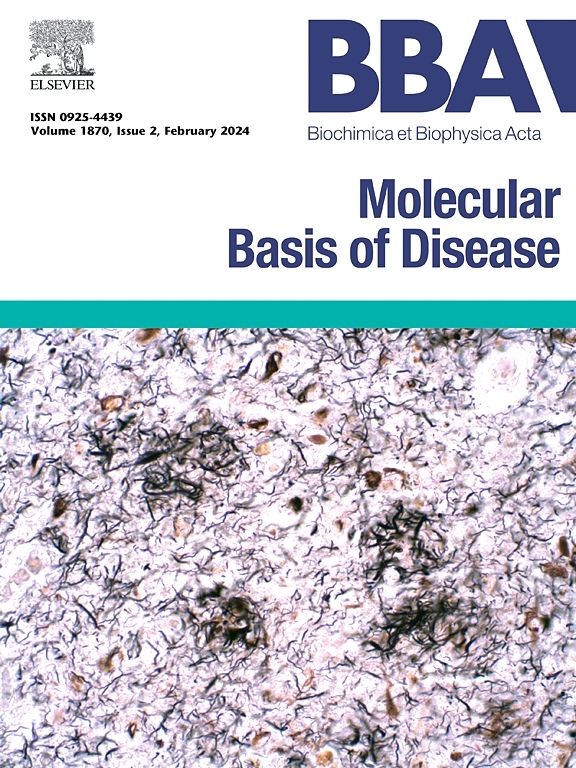萎缩性胃炎中人胃上皮细胞癌变机制的探讨
IF 4.2
2区 生物学
Q2 BIOCHEMISTRY & MOLECULAR BIOLOGY
Biochimica et biophysica acta. Molecular basis of disease
Pub Date : 2025-04-10
DOI:10.1016/j.bbadis.2025.167843
引用次数: 0
摘要
背景幽门螺杆菌感染和随后的萎缩性胃炎(AG)和肠化生(IM)被认为是胃癌(GC)的前兆。虽然已经通过小鼠模型阐明了AG和IM的多种致癌机制,但很少有使用人体模型的研究报道。在这里,我们描述了IM的体外模型,以及使用人胃类器官的AG致癌转化的体内模型。方法利用免疫组织化学和原位杂交技术,建立来自AG患者的类器官。采用生态位因子退出和CRISPR/Cas9基因工程技术建立IM模型,并将处理后的类器官移植到小鼠皮下建立GC模型。结果类器官(AGOs)由Wnt生态位因子维持;这些因素的退出导致向中央凹细胞分化。敲除runt相关转录因子3 (RUNX3)或激活骨形态发生蛋白(BMP)信号,导致关键IM标记尾型同源盒2 (CDX2)和粘蛋白2 (MUC2)在AGOs中积累;SMAD4的破坏抵消了这些标记的诱导。与runx3缺陷类器官相比,TP53和SMAD4双重缺陷的类器官形成了更大、更增殖的p21阴性皮下肿瘤,这表明衰老状态的诱导是AG逐步致癌的关键屏障。结论swnt信号在AG稳态中起重要作用,而smad4依赖性的BMP信号激活可促进肠道分化。TP53和SMAD4的联合破坏通过抑制p21的诱导赋予了AGOs致瘤潜能。本文章由计算机程序翻译,如有差异,请以英文原文为准。

Elucidation of the mechanism of carcinogenic transformation of human gastric epithelial cells in atrophic gastritis
Background
Helicobacter pylori infection and subsequent atrophic gastritis (AG) and intestinal metaplasia (IM) are regarded as precursor conditions for gastric cancer (GC). Though diverse mechanisms of carcinogenesis from AG and IM have been clarified using mouse models, few studies using human models have been reported. Here, we describe in vitro modeling of IM, as well as in vivo modeling of the oncogenic transformation from AG using human gastric organoids.
Methods
Organoids derived from patients with AG were established and characterized by immunohistochemistry and in situ hybridization. Niche factor withdrawal and genetic engineering using CRISPR/Cas9 were conducted for modeling IM, and manipulated organoids were xenografted subcutaneously in mice to establish a GC model.
Results
AG organoids (AGOs) were maintained by Wnt niche factors; withdrawal of these factors led to differentiation toward foveolar cells. Knockout of Runt-related transcription factor 3 (RUNX3), or activation of bone morphogenetic protein (BMP) signaling, resulted in accumulation of the key IM markers caudal-type homeobox 2 (CDX2) and mucin 2 (MUC2) in AGOs; disruption of SMAD4 counteracted the induction of these markers. Organoids doubly deficient for TP53 and SMAD4 formed larger and more proliferative p21 -negative subcutaneous tumors than did RUNX3-deficient organoids, suggesting that induction of a senescent state is a key barrier in stepwise carcinogenesis from AG.
Conclusions
Wnt signaling is essential for homeostasis of AG, and SMAD4-dependent activation of BMP signaling promotes intestinal differentiation. Combined disruption of TP53 and SMAD4 confers tumorigenic potential to AGOs by inhibiting p21 induction.
求助全文
通过发布文献求助,成功后即可免费获取论文全文。
去求助
来源期刊
CiteScore
12.30
自引率
0.00%
发文量
218
审稿时长
32 days
期刊介绍:
BBA Molecular Basis of Disease addresses the biochemistry and molecular genetics of disease processes and models of human disease. This journal covers aspects of aging, cancer, metabolic-, neurological-, and immunological-based disease. Manuscripts focused on using animal models to elucidate biochemical and mechanistic insight in each of these conditions, are particularly encouraged. Manuscripts should emphasize the underlying mechanisms of disease pathways and provide novel contributions to the understanding and/or treatment of these disorders. Highly descriptive and method development submissions may be declined without full review. The submission of uninvited reviews to BBA - Molecular Basis of Disease is strongly discouraged, and any such uninvited review should be accompanied by a coverletter outlining the compelling reasons why the review should be considered.

 求助内容:
求助内容: 应助结果提醒方式:
应助结果提醒方式:


